Hagia Sophia is one of the most important monuments of world architectural history to have survived to the present day.
Hagia Sophia Map, Directions, Neighbourhoods

Hagia Sophia was a grandest place of worship for over 900 years, and arguably the most perfect and beautiful church that has been erected by any Christian people.
Hagia Sophia is a historical phenomenon in the list of world heritage sites by UNESCO. The history of Hagia Sophia dates back to ancient times. Hagia Sophia, one of the most important places of worship of the Eastern Roman Empire in its time, serves as a mosque today. Hagia Sophia is a historical mosque recognized as a World Heritage site by UNESCO. Its history dates back to ancient times and was once an important place of worship for the Eastern Roman Empire. Today, it serves as a mosque and continues to hold great significance.
SUMMARY
- Attraction Type :Historical Site, Museum, Mosque, Church / Monastery
- Entrance Fee (Appr.USD) :27
- Visiting Time (hours): 2
- Dress Code: Clean socks / Proper dress for Ladies provided at the entrance (Body and Head must be covered) / Men: at least t-shirt and Pants under knee level
- Special Tips:Crowded at prayer times
- Open: Everyday 9:00 am-6:00 pm
Table of Contents
- Is Hagia Sophia Church or Mosque?
- Hagia Sophia meaning and definition
- Hagia Sophia Photos:
- Hagia Sophia Drone Shot Video
- Where is Hagia Sophia located?
- Why is Hagia Sophia so important?
- History of Hagia Sophia
- Facts About Hagia Sophia Architecture and Structure
- Hagia Sophia Interior Parts
- Apse Mosaic in Hagia Sophia
- Two Angels in the Apse
- Viking Writing in Hagia Sophia
- Leon VI Mosaic
- Offering Mosaic
- Angel Depictions on the Dome of Hagia Sophia
- Patriarch Mosaics in Tympanon
- Emperor Alexander Mosaic
- Zoe and Komnenos Mosaics
- Deisis Composition in Hagia Sophia
- Omphalion in Hagia Sophia
- Hagia Sophia Wish Column
- Hagia Sophia Minarets
- Hagia Sophia Buttresses
- Hagia Sophia Marble Cubes
- Hagia Sophia Minbar
- Hünkâr Mahfili (Sultans Gathering Place)
- Hagia Sophia Mihrab
- Tiles Around the Mihrab
- Calligraphy Plates in the Mihrab Section
- Hagia Sophia Fountain
- Mosaic Tughra of Sultan Abdülmecid in Hagia Sophia
Is Hagia Sophia Church or Mosque?
Hagia Sophi had been serving as a church for 916 years and was converted into a mosque after Mehmed the Conqueror conquered Istanbul in 1453. It was used as a mosque for 482 years until it was converted into a museum in 1935 by the order of Atatürk and the decision of the Council of Ministers. However, in 2020, President Recep Tayyip Erdoğan ordered it to be converted back into a mosque and opened for worship by Muslims.
Hagia Sophia meaning and definition
When the Hagia Sophia was originally constructed, it was referred to as the Great Church or Megale Ekklesia. However, it became more commonly known as Sophia during the fifth century. Despite this, the general public continued to refer to it as the Great Church. Following the Ottoman conquest of Constantinople in 1453, the name was changed to “Hagia Sophia,” which is the name it is still known today.
Saint Sophia
The idea that the building was dedicated to a saint named Sophia is wrong. The church was dedicated to Theia Sophia, Holy Wisdom, the second element of the Christian trinity. The current name; Hagia Sophia, is composed of the words Aya (holy, saint) and Sophos (wisdom), which means holy/divine wisdom.
Hagia Sophia Photos:
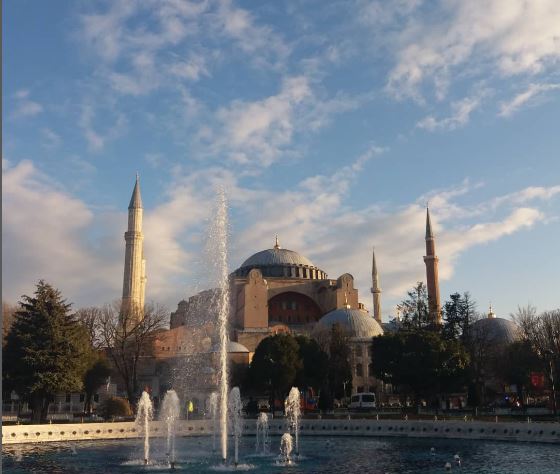
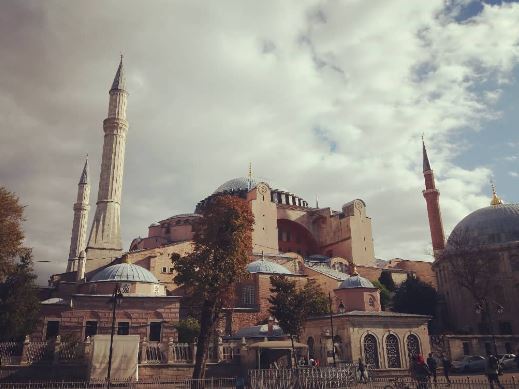


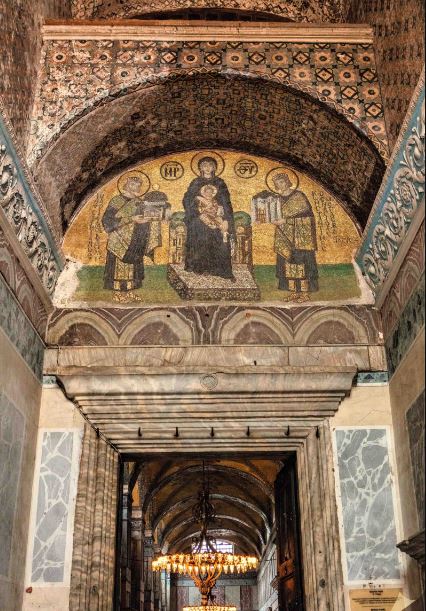

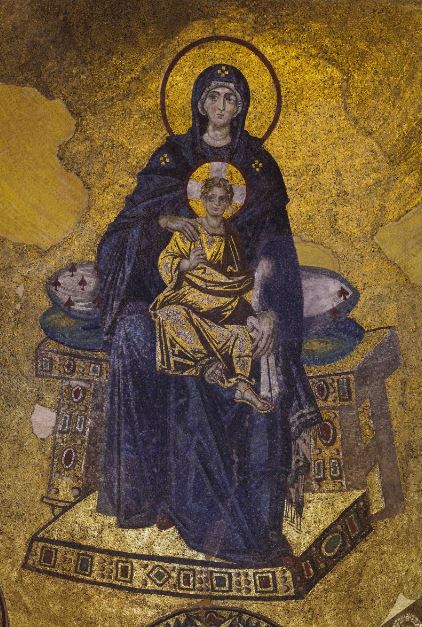

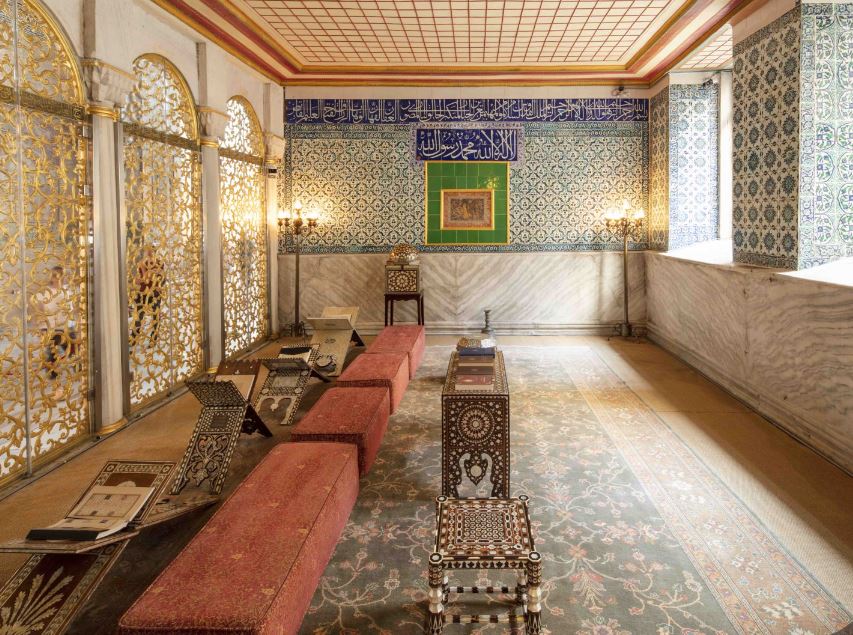
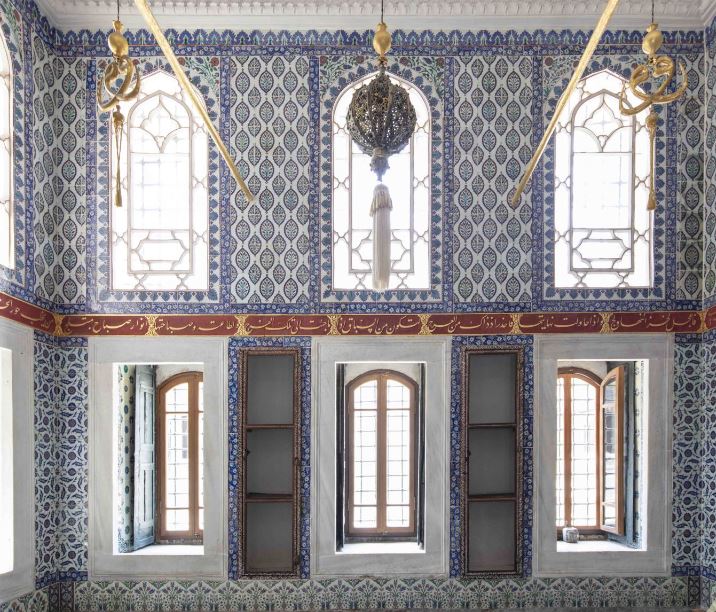
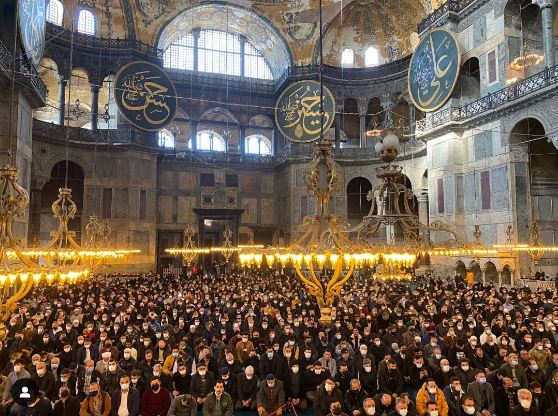





Hagia Sophia Drone Shot Video
Where is Hagia Sophia located?
The easiest way to reach Hagia Sophia Mosque is via Marmaray and tram lines for both sides of Istanbul.
Tram: You can take the Bağcılar-Kabataş direction tram line and get off at Sultanahmet stop.
Marmaray: You can get off at the Sirkeci stop and either walk or take the tram you will see at the exit and continue on your way.
Ferry and Motorboat: You can choose an easy transportation by sea from the Anatolian Side to the European Side. You can take the ferries from Kadıköy or Üsküdar to Eminönü. When you get off, you can either walk or use the tram.
Arriving by car could be a problem for this region. Although there are parking lots in Historical Peninsula such as the Sirkeci and Topkapi Palace, which are very busy especially on weekends, we recommend that you leave as early as possible.
Why is Hagia Sophia so important?

Hagia Sophia is a historical monument of great importance. It holds the distinction of being the world’s oldest and fastest-built cathedral. For 1000 years after its construction, it remained the largest cathedral until the completion of the Seville Cathedral in Spain in 1520. It is often referred to as “the 8th wonder of the world”, which is not an exaggeration considering its international importance and advanced architecture.
The monument is one of the most valuable artistic and architectural monuments in the world, with religious significance that adds to its cultural value. As a result, it is one of the most visited tourist attractions in the world.
However, despite its popularity, many people have a superficial understanding of Hagia Sophia, which is a place of great detail and mystery. The average person’s knowledge of this Byzantine monument is limited to the fact that it was the largest building in the world in its time, that it was converted into a mosque after the conquest of Istanbul, that it served as a museum, and that it is now a mosque again.
History of Hagia Sophia
Hagia Sophia was built not once but 3 times in the same place until it took its current form. After it was built for the last time, it remained the largest cathedral in the world for 1000 years. It was the center of religious life in Istanbul, the capital of both the Roman and Ottoman Empires.
While the two Hagia Sophias before the last one were destroyed by fires in riots, the dome of the current Hagia Sophia was destroyed by an earthquake and rebuilt. Now we will briefly talk about the history of the 3 Hagia Sophia’s:
First Hagia Sophia
The construction of the first church was initiated by Constantine the Great (Constantine I, 272 AD 337 AD), who made Constantinople the capital of the Roman Empire, liberalized Christianity with the Edict of Milan and led the way to the Council of Nicaea, where the binding rules of Christianity were established. It was completed and opened for worship in 360 AD by his son Constantius. The first church was called Megalo Eklesia, which means Great Church in Greek, but it was burned down in a popular uprising in 404 AD and not much was left.
Second Hagia Sophia
The 2nd church, which was built by Emperor Theodosius II (408-450 AD) in 415, was destroyed during the Emperor Justinian’s (527-565 AD) reign in 532 AD during the great popular uprising known in history as the Nika Revolt.
What remains of the 2nd church are the columns in the courtyard and garden. In addition, excavations in 1935 uncovered the stairs of the monumental entrance of the second church, about two meters below the floor of the present church, and fragments of the frieze decorated with reliefs of sheep symbolizing the 12 apostles. You can examine all of these by spending some time in the garden of the Hagia Sophia before entering the building.
Today’s Hagia Sophia: Third Hagia Sophia
The third Hagia Sophia, which has survived to the present day, was built by Emperor Justinian (527-565 A.D.) for the physicist Isidoros of Miletus and the mathematician Antemios of Trales, now Aydın. The construction began on February 23, 532 and was completed in 5 years and opened for worship on December 26, 537. Antemios died in the second year of construction, but Isidoros completed the building. The construction involved 1000 craftsmen and craftsmen and 10,000 workers. Hagia Sophia, the oldest cathedral in the world, is also the fastest built cathedral in the world.
Sacked during a crusade:
During the Fourth Crusade, the Crusaders under the command of Enrico Dandolo, the 41st Doja of the Venetian Republic, captured Constantinople and sacked the Hagia Sophia. During this period, Hagia Sophia suffered great destruction.
Hagia Sophia after the conquest of Istanbul

In 1453, with the conquest of Istanbul, Hagia Sophia was converted into a mosque and Islamic elements were added to the structure. The first minaret was built in Hagia Sophia during the reign of Fatih Sultan Mehmet. This wooden minaret does not survive to this day. Later, during the reign of Sultan Bayezid II, another minaret was added to the building.
During the reign of Selim II (1566-1574), Sinan the Architect reinforced the Hagia Sophia and its dome with buttresses and arches and added a minaret, the hünkar mahfili and Selim II’s tomb. In the 1600s, the mausoleums of Murat II and Mehmed III were added to the building.
During the Ottoman period, many more additions were made to the building, such as the marble pulpit, the gallery leading to the khünkar mahfil, the muezzin mahfil, and the sermon pulpit. Murad III places two cubes made of “bektashi stone” from the Hellenistic period, excavated from the ancient city of Pergamon, in the main hall of Hagia Sophia. Mahmud I added a library, a madrasah, an almshouse and a fountain to the building. Thus, Hagia Sophia turns into a complex.
During the reign of Abdülmecit, Hagia Sophia undergoes one of the most famous restorations of the Ottoman period. Between 1847 and 1849, the Italian-born Fossati brothers reinforced the dome, vaults and columns of the building and overhauled its interior and exterior decoration. They cleaned the mosaics on the upper floor and covered the badly damaged ones with plaster. They also painted the mosaic motifs underneath on this plaster. The giant round paintings of important names written in calligraphy by Kazasker Mustafa İzzed Efendi (1801-1877) are being renovated and hung on the columns.
Hagia Sophia’s becoming a museum and then a mosque again
Hagia Sophia became a museum on February 1, 1935 and was inscribed on the UNESCO World Heritage List in 1985 as part of the “Archaeological Park”, which includes Hagia Sophia, Hippodrome, Hagia Irene, Little Hagia Sophia Mosque and Topkapı Palace. It was finally reverted back to “Mosque” status on July 24, 2020. The floor was carpeted and the mosaics in the prayer area were covered with an electronic rail system curtain that opens and closes in 1 minute. These curtains are activated at prayer times and when the prayer is over, the mosaics are opened again. Among the mosaics and frescoes that are covered during prayer are the Absis Mosaic (Theotokos Mosaic), the Gabriel mosaic next to it and the Seraphim Angels frescoes on the pendants.
Facts About Hagia Sophia Architecture and Structure

Columns and marbles of Hagia Sophia brought from ancient cities
For the reconstruction of the church, Iustinian ordered materials from all over the empire, and he also had materials from old buildings collected. Eight large red porphyry columns were brought from Heliopolis in Egypt, columns from the Temple of Artemis in Ephesos in western Anatolia, columns from Kyzikos and Ba’lebek in Syria. In addition, marbles of different types and colors from different regions were transported here.
Hagia Sophia Dome

The most important innovation in the architecture of Hagia Sophia was the size and height of the dome dominating the central space, which was unusually large for a church.The height of the dome covering the main space is 55.60 meters from the ground, and its diameter is 31.87 meters in the north-south direction and 30.86 meters in the east-west direction.When Hagia Sophia was being built, marble, stone and bricks were used by the architects in the construction of the building, and light and strong bricks specially produced from Rhodes soil were used so that the dome would not collapse easily in earthquakes.
Gate of the Emperors
Called the Emperor’s Gate because it was used only by the Emperor and his entourage, it provides access from the inner narthex to the main space in Hagia Sophia. It is the largest door of Hagia Sophia and is made of oak wood, 7 meters high, with a bronze frame. Dating to the 6th century, the wings of the door are covered with bronze plates. Eastern Roman sources claim that it was made from the wood of Noah’s Ark. The mosaic on it is the first mosaic of Hagia Sophia to be unearthed.
Hagia Sophia Interior Parts
Apse Mosaic in Hagia Sophia
It is thought that all figured mosaics in the building were removed with the Iconoclasm period. In 843, after the end of this period, the first figural mosaic, the Apse Mosaic, was created in Hagia Sophia. In the mosaic; Mary is depicted in the center, sitting on a cushioned throne decorated with precious stones. In her lap, she holds the child Jesus.
Two Angels in the Apse
On the right side of the apse is a depiction of Gabriel and on the left side is a depiction of Michael. While the depiction of Gabriel has survived for the most part, the holy wing tip and part of the foot have survived in the depiction of Michael. It is thought that the depiction of these two angels was added to the apse in the second half of the 9th century.
Viking Writing in Hagia Sophia
In the center of the south gallery, above the marble railings, there is a Viking inscription that appears to date from the 9th century. This inscription reads “Halvdan was here”. It is thought to have been written by a Viking soldier who worked as a mercenary in the Eastern Roman army.
Leon VI Mosaic
Dating to the 10th century, the mosaic is located on the Emperor’s Gate. In the center of the scene, Jesus is depicted holding an open Bible in his left hand. With his right hand, he blesses Emperor Leon VI (816-912), who is depicted prostrate at his feet. On the right side of the mosaic is Gabriel in a medallion, and on the left side is Mary, also in a medallion.
Offering Mosaic
It is located above the Beautiful Gate on the south side of the inner narthex. The mosaic above the ceremonial door used by the Empire and its family was unearthed by Fossati in 1849 during the restoration of Hagia Sophia. In the center of the panel consisting of gold mosaics, Mary and the child Jesus are depicted. On the left side of Mary is Constantine with a figure symbolizing Constantinople, and on the right side is Iustinianus with a figure symbolizing Hagia Sophia. It is explained here that the emperors offered the city and the church to Mary to protect the city and the church.
Angel Depictions on the Dome of Hagia Sophia
In each corner of the pendentives, Seraphim angels, who are believed to guard the throne of God in heaven, are depicted. The angel depictions in the eastern part are made of mosaic. The ones in the west were renovated as frescoes because they were damaged during the Eastern Roman Period. The angel depictions were covered during the Ottoman Period.
Patriarch Mosaics in Tympanon
Although their exact date of construction is unknown, these mosaics, which are thought to have been made between the 9th and 10th centuries, are located in half-arched niches in the tympanon walls on the north side of the building. Only three of the patriarch figures depicted in the mosaics have survived in good preservation. The first niche depicts Ignatios the Younger, Patriarch of Constantinople, the fourth niche depicts St. Ioannes Chrysostomos, Patriarch of Constantinople, and the sixth niche depicts St. Ignatios Theophoros, Patriarch of Antiocheia. The figure depicted in the seventh niche is thought to be Athanasius.
Emperor Alexander Mosaic
The mosaic in the southwestern part of the north gallery depicts his brother Emperor Alexander (912-913), whom Leon VI made a partner in his reign. Dated to the 10th century, it is one of the most intact mosaics among the Hagia Sophia mosaics.
Zoe and Komnenos Mosaics
The Zoe Mosaic, one of these mosaics on the wall at the eastern end of the south gallery of Hagia Sophia, dates to the first half of the 11th century. In its present form, it depicts Christ seated in the center and Empress Zoe and her husband Emperor Constantine IX (1042-1055) placed on either side of him. While the present version of the mosaic depicts Constantine IX, the mosaic was probably first painted during the reign of Zoe’s first husband Romanos III (1028-1034).
The Komnenos Mosaic depicts Mary standing in the center holding the child Jesus in front of her and Emperor Ioannes II Komnenos (1118-1143) and his wife Empress Eirene on either side. On the right side of the mosaic is their son Alexios.The subject of these two mosaics is generally accepted to be the donations made by the emperors to Hagia Sophia.The money pouches in the hands of the emperors in the mosaics prove this.15- Tombstone of Commander Henricus DandoloThe tombstone opposite the Deisis Mosaic belongs to Commander Henricus Dandolu, who led the IVth Crusade and died in Constantinople in 1205.
Deisis Composition in Hagia Sophia
The Deisis Mosaic on the pediment of the door leading to the gallery in the priest’s room is one of the most famous mosaics of Hagia Sophia.Although there are different opinions about its dating, the mosaic, which is accepted to have been made in the 13th century, is considered an important beginning in Eastern Roman Painting Art.The mosaic depicts Jesus in the center of the scene with Ioannes Prodromos on the right and Mary on the left. Mary and Ioannes Prodromos are depicted as praying to Jesus for the forgiveness of humanity on the Day of Judgment. All three figures reflect the Hellenistic Period depiction art.
Omphalion in Hagia Sophia
The omphalion, the room where the emperors were ceremonially crowned in Eastern Rome, is an area where circles of different colors and sizes around a large marble circle and opus sectile style decoration are seen in the parts where they meet.
Hagia Sophia Wish Column
The northwestern column with a carved center is called the sweating column or the wishing column. There are several rumors about the column.According to one of them; Emperor Iustinianus, while walking around the building in a severe headache, realized that his headache was gone as soon as he leaned against this column, and when this event was heard among the people, it began to be believed that this column was healing. According to another rumor; after the building was converted into a mosque, the first Friday prayer to be performed here could not be started because the direction of the building was not facing the Kaaba, but at that time “Hızır Alayhisselam” came and tried to turn the direction of the building to the Kaaba by taking power from this column. However, it is said that this incident was noticed by a member of the public and he disappeared before he could turn the mosque.
The habit that has survived from the rumors to the present day is that people make a wish by rotating their thumbs clockwise one full turn in this groove in the pillar.
Hagia Sophia Minarets
After the Hagia Sophia church was converted into a mosque after the conquest of Istanbul, a wooden minaret was built by Fatih on one of the half domes, but this minaret has not survived to the present day.The minaret in the southeast belongs to the reign of Sultan Mehmet the Conqueror or Bayezid II. The minaret on the Bab-ı Hümayun side is thought to have been built by Mimar Sinan II during the reign of Selim II due to its similarity with the minarets of the Selimiye Mosque in Edirne.The twin minarets on the southwest and northwest sides were built by Mimar Sinan during the reign of Sultan Murad III.During the repairs in the 15th, 16th and 19th centuries, ornaments were added to the minarets according to the style of the period.
Hagia Sophia Buttresses
Due to the weight of the dome, the walls of the Hagia Sophia were subjected to certain strengthening interventions during the Eastern Roman Empire and the Ottoman Period due to the outward expansion, but these were not sufficient. For this reason, both the Eastern Romans and the Ottomans tried to prevent the pressure of the dome by building buttresses from the outside of the building.
Sinan the Architect found a solution to this problem by supporting the structure with arch additions and heavy supporting walls in the gaps between the piers and side walls carrying the dome.The supporting walls built during the Eastern Roman period were rebuilt and enclosed in stone enclosures.Some of the 24 buttresses, 7 in the East, 4 in the South, 4 in the North, 5 in the West and 4 in the weight towers, were built in the Eastern Roman period and some in the Ottoman period.
Hagia Sophia Marble Cubes
Two cubes made of monolithic marble from the Hellenistic Period, found in the ancient city of Pergamon, were brought to Hagia Sophia during the reign of Sultan Murad III. There are faucets at the bottom of the cubes.Capable of holding 1250 liters of liquid, these cubes were used to distribute sherbet during the lamps and Eid prayers.
Hagia Sophia Minbar
The pulpit, built during the reign of Sultan Murad III, is located to the right of the mihrab. Dating back to the 16th century, the minbar is one of the most beautiful examples of marble workmanship of this period.
Hünkâr Mahfili (Sultans Gathering Place)
When Sultan Ahmed III had Hagia Sophia completely overhauled, he had the Hünkar Mahfili, which he ordered with his own taste, built in 1728.During the maintenance and repair work carried out by Sultan Abdülmecid II, this mahfil was replaced with a new one in 1847.The Hünkâr Mahfili consists of a hexagonal section on five columns and a corridor also on columns. The lower part consists of a marble openwork balustrade slab. There is a gilded wooden cage above it.
Hagia Sophia Mihrab
The mihrab, located in the south-east of the main space, was repaired and added to by the Ottoman sultans from time to time.Renovated in the 19th century, the mihrab has a polygonal niche with a sunburst and star motifs and a half-domed arch.Many gold stars are used on the mihrab and it has a flamboyant crown. On both sides of the mihrab are candlesticks brought from the palace church of Hungarian King Matyas I during the conquest of Budin during the Hungarian campaign of Suleiman the Magnificent (1520-1566).
Tiles Around the Mihrab
There are tile panels in the cloisters to the right and left of the mihrab. On the left side, there is a 16th century Iznik tile panel with plant motifs belonging to the Old Hünkar Mahfili.On the right side, there is a depiction of the Kaaba consisting of eight pieces and a depiction showing the tomb of the Prophet Muhammad.
Calligraphy Plates in the Mihrab Section
On the right side of the mihrab are calligraphy plates of Ottoman sultans.From top to bottom; 1st calligraphy plate, Sultan Mahmud II (1808-1839), 2nd calligraphy plate, Sultan Mahmud II (1808-1839), 3rd calligraphy plate, Sultan Ahmed III (1703-1730), 4th calligraphy plate, Sultan Mustafa II (1695-1703), 5th calligraphy plate, Sultan Mustafa II (1695-1703). On the left side, there are works by Mehmed Yesari and Sheikhulislam Veliyüddin Efendi.
Hagia Sophia Fountain
It was built by Sultan Mahmut I during the repair and construction of additional buildings at Hagia Sophia (1740-1741). It was built on a large scale in the area between the gate and the Sıbyan School, which was built in the area where the west entrance of the building was not used for a long time.
The fountain has a portico with eight pointed arches with wide openings based on eight columns with muqarnas.In the center of the structure is a marble water pool with 16 sections.In the center of the pool is a marble fountain belly.A small dome rises in the center of the wooden canopy. The inside of the dome is divided into sections with gilded slats on a blue background. The general architecture of the building adheres to the traditions of classical Turkish style. In the ornamentation, there are motifs in accordance with the Turkish art style as well as motifs made in accordance with the Baroque style.28- Sultan Mahmud I Library
The Sultan Mahmud I Library, also known as the Hagia Sophia Library, was founded by Sultan Mahmud I and inaugurated on April 21, 1740.According to historian Subhi Mehmet, when the library was founded, it had a collection of 4000 works.Part of this collection consisted of books from the Treasury-i Amire, while the other part consisted of books gifted to Mahmud I by the Grand Vizier, the Sheikhulislam, the Darüssaade Agha and other statesmen. The catalog of the books here includes an introduction to Mahmud I’s founding of the library and the seals of approval of the inspector of Haremeyn and the Anatolian and Rumeli kazasker.
Mosaic Tughra of Sultan Abdülmecid in Hagia Sophia
The tughra carved in mosaic on a round plate on the wall on the right side of the large door belongs to Sultan Abdülmecid (1839-1861). The 19th century Ottoman sultan’s tughra made of mosaics is important as it is the only sultan’s tughra made with mosaic grains in Turkish Art.
For the monogram of Sultan Abdülmecid, who wanted this important building to be seriously repaired and overhauled, the architect Fossati, who was commissioned for the repair of Hagia Sophia, saw it appropriate to use the mosaic grains that were spilled during the repair of Hagia Sophia and then collected for the sultan’s monogram.Thus, he commissioned the Italian mosaic artist Lanzoni. Lanzoni engraved Abdülmecid’s monogram on a round plaque with colored mosaic grains on a background covered with gold grains. At the time of its creation, this work could not be placed anywhere and was forgotten.Many years later, this work was found in the warehouse of the Topkapı Palace Museum.Later, the tughra was placed on the side wall of the main entrance known as the Emperor’s Gate, which opens to the main space in Hagia Sophia.30- Eight Large Calligraphy PlatesThese plates were written in gold gilding on a green background made of hemp by the calligrapher Kazasker Mustafa İzzet Efendi during the repairs made between 1847 and 1849 during the reign of Sultan Abdülmecid (1839-1861).The eight plates with the names “Allah, Prophet Muhammad, Four Caliphs; Prophet Abu Bakr, Prophet Umar, Prophet Osman, Prophet Ali and Prophet Muhammad’s grandsons Prophet Hasan and Prophet Hussein” are known to be among the largest calligraphy plates in the Islamic World. It is known that the plates in Hagia Sophia, which underwent a change after the conquest, changed their course in line with the wishes of the sultans who came to rule. The diameter of the giant plates is 7.5 meters and the letter thickness is 35 cm.
